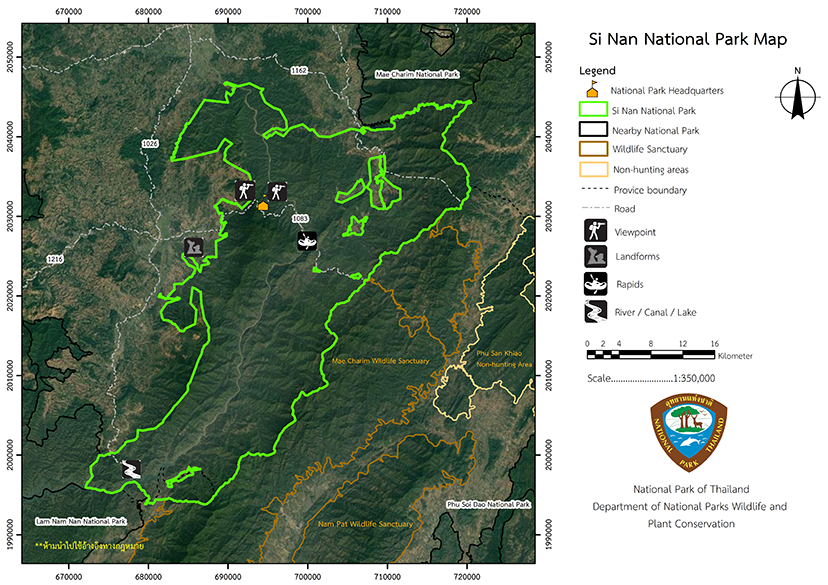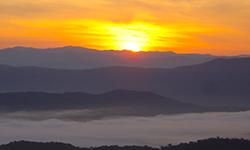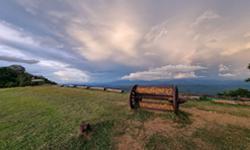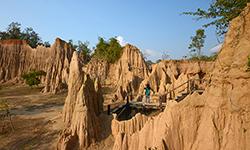Si Nan National Park
Contact Location : Si Nan National Park, P.O. Box 14, Na Noi District, Nan Province 55150
Telephone Number : (+66) 9 8685 3293, (+66) 9 3242 2914
Email : srinan_13@hotmail.com
Facebook : Sri Nan National Park
Information
Si Nan National Park spans the of Na Muen, Na Noi, and Wiang Sa District in Nan Province, encompassing both sides of the Nan Stream until it reaches the Khuean Sirikit Reservoir. The forest is fertile and is surrounded by high fold mountains (complex mountain) which run on a north-south axis. It is a forest and river ecosystem that is significant for the development of the Nan River, a vital water source. Numerous essential plants exist, as well as habitats for wild animals, and it is endowed with natural features that include Sao Din and Khok Suea, Pak Nai, Kaeng Luang, Doi Pha Chu Viewpoint, scenery on both sides of the Nan River, Doi Samor Dao, and Pha Hua Sing Viewpoint. It is approximately 640,237.50 rai or 1,024 square kilometers in size.
Background
In 1992, Royal Forest Department issued an order 475/2532 dated March 23rd, 1989, assigning Mr. Sombat Wiangkham, Forestry Officer Level 4 working at Nam Nao National Park to move to Wiang Kosai National Park, and to conduct a preliminary survey into the National Reserved Forest, Nam Wa Forest, Huai Sali Forest, Salik Forest, , and Mae Sakhon Fang-Sai Forest, Huai Mae Khanning Forest and the upper of the Nam Sa Fang-Khwa Forest, Wiang Sa District, Nan Province, totaling 435 square kilometers or 271,875 rai. The order No. 1627/2532 dated October 19, 1989, was to further explore the area for the establishment of a National Park and given the name of the national reserved forest, which is a waterhead, as "Mae Sakorn National Park" and abbreviated as No. Ko So 0713 (Mo So Kho) / in accordance to the letter No. Ko So 0713/674 dated May 24th, 1990 issued by the National Park Division.
The Royal Forest Department issued order No. 1627/2532 dated October 19, 1989, requiring Mr. Sombat Wiangkham to explore additional areas within the Nam Sa - Mae Sakhon Fang-Sai National Reserved Forest, Huai Mae Khaning Forest and Nam Sa Fang-Khwa Ton Bon Forest, in Wiang Sa District, Nan Province, and to declare the area a National Park in accordance with Section 6 of the National Park Acts 1961. Later, Mae Sakhon National Park received a letter No. Ko So 0713 (Mo So Kho)/33 dated June 14th,1991, identifying areas for further exploration beyond the original area, including the Pa Fang-Khwa Mae Nam Nan Ton Tai Forest, and Huai Nguang, Huai Sali National Reserved Forest, and Nam Wa and Huai Sali National Reserved Forest, in Wiang Sa District, Na Noi District, and Na Muen District, Nan Province.
The National Park Division approved additional exploration of the forest area in a letter No. Ko So 0713.2 / 1568 dated August 26th, 1991. Together with the Nan Provincial letter No. No No 0009/5857 dated April 19, 1993, in support of the site's designation as a National Park. Si Nan National Park was later approved by Mr. Pong Lengyi, Director-General of the Department of Forestry. Si Nan National Park was established on January 12th, 1994, according to the National Park's letter, Ko So 0712.03 / 47 dated January 12th, 1994. An additional 934 square kilometers (583,750 rai) of land was surveyed although it was occupied by residents of a large village that has been carved out of the Si Nan National Park.
Due to additional exploration and relocation of the National Park Headquarters, which resulted in confusion when calling and coordinating with other government agencies, the park was renamed Si Nan National Park according to the National Park Headquarters' letter Ko So 0712.3/47, dated January 12th, 1994.
Later in 2007, the boundaries of Nam Wa Forest and Huai Sali forest the upper of Pa Fang-Khwa Mae Nam Nan Forest, as well as the Huai Nguang and Huai Sali forests brought inside. The localities of Khueng, San and Nam Muap Sub-district, Wiang Sa District, Si Saket, Chiang Khong and Sathan Sub-district, Na Noi District, and Bo Kaeo and Na Thanung Sub-district, Na Muen District, were all now part of the park, which became Thailand’s 104th National Park in the country, according to the Government Gazette, Volume 124, Section 25 Ko, dated May 25th, 2007.
Note : After paying the entrance fee to the National Park, please carry the receipt for inspection.
640,237.50 rai (1024.3 square kilometers)
|
|
|
|
|
|
|
|
|
|
||
Stargazing ⇔ Camping
Welfare shop : 08:30 - 16:30 hrs.
Mobile phone signal:
National Park Headquarters area: AIS, DTAC, TRUE
|
|
The topographical features are those of fold mountains (complex mountain), resembling a mountain range, which runs north-south. Doi Prae Mueang and Doi Khun Huai Huk are significant peaks along with Doi Luang and Khun Huai Ya Sai, which is 1,234 meters above sea level. The area includes a forest that acts as a catchment area for the Nan River There are many creeks occurring from springs, with larger waterways including the Khaning River and Sa River.
|
|
The climate is classified into three seasons: summer, which lasts from February to April, rainy season, which lasts from May to October, and winter, which is cold by Thai standards, occurs between November and January, and the rainy season, which lasts from July to September. Temperatures average around 24 degrees Celsius.
|
|
|
|
The topographical features are those of fold mountains (complex mountain), and the forest types are classified as non-deciduous, dry evergreen forest, hill evergreen forest, and coniferous forest (pine forest). Among the species discovered are Anisoptera costata, Malabar Iron Wood, Dipterocarpus, Burma Padauk, Black Rosewood, Toona ciliata, Lagerstroemia calyculata Kurz, Tamalin, Hairy Keruing, Dipterocarpus tuberculatus, Anogeissus acuminata, and the ground plants include are Microcos paniculata, Litsea glutinosa, Merkus Pine (Pinus merkusii Jungh & De Vriese), and Khasiya Pine (Pinus kesiya Royle ex Gordon). The deciduous forest includes mixed deciduous forest and deciduous dipterocarp forest which houses woods such as Teak, Xylia xylocarpa, Burma Padauk, Tamalin, Yellow Millettia, Papilionaceae, Black Rosewood, Lagerstroemia calyculata Kurz, Vitex pinnata, Easter Tree, Burma Sal, Burmese Sal, Hairy Keruing, Dipterocarpus tuberculatus, Schleichera oleosa, Mangifera caloneura, Haldina cordifolia, Terminalia alata Heyne, Spondias pinnata, and bamboos. The most common wild animals are Gaurs, Bantengs, sambar deers, wild boars, bears, Bengal Tiger, leopards, gibbons, Slow Lorises, Dholes, Golden Jackals, Mouse Deers, Common Palm Civets, Fishing Cats, Burmese Hares, Treeshrews, Squirrels, Foxes, and various birds, which include Thai Peacocks, and various reptiles and amphibians, which can be found in natural water sources. |
How to get there by car :
From Bangkok travel through the provinces of Nakhon Sawan, Phitsanulok, and Phrae, from where you can take the Yantrakitkosol Road to the Wiang Sa District. Take the first right onto Chao Fa Road, and thenProvincial Highway No. 1026, which connects the districts of Wiang Sa and Na Noi district. After approximately 35 kilometers, bear left onto Na Noi - Pang Hai Road, Provincial Highway No. 1083, for approximately 5 kilometers to Sao Din, where the National Park Headquarters are located.
- National Park Ranger Station So No No. 1 (Nong Bua)
- National Park Ranger Station So No No. 2 (Na Doi)
- National Park Ranger Station So No No. 3 (Kitti Beach)
- National Park Ranger Station So No No. 4 (Sali)
- National Park Ranger Station So No No. 5 (Kaeng Luang)
- National Park Ranger Station So No No. 6 (Pak Nay)
- National Park Ranger Station So No No. 7 (Huai Ngam)
- National Park Ranger Station So No No. 8 (Kew Nok Saew)
- National Park Ranger Station So No No. 9 (Huai Phai)
- Accommodation - Si Nan 101 (Chao Chan)
- Accommodation - Si Nan 102 (Chao Ueang)
- Accommodation - Si Nan 202 (Phana Phrai 1)
- Accommodation - Si Nan 203 (Phana Phrai 2)






